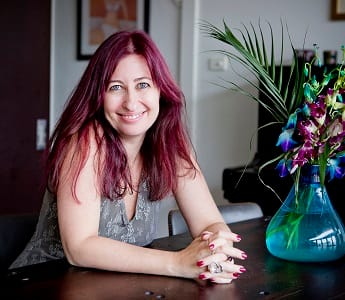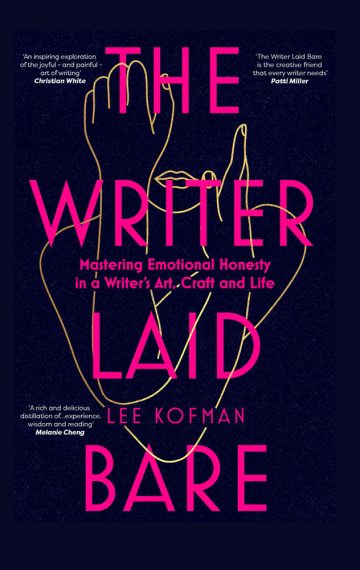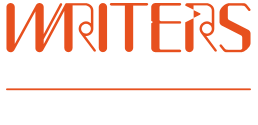
Lee Kofman is the author of six books, including Imperfect (2019, Affirm Press), which was shortlisted for Nib Literary Award 2019, and The Dangerous Bride (2014, MUP); editor of Split (Ventura, 2019), which was longlisted for ABIA Awards 2020, and co-editor of Rebellious Daughters (Ventura, 2016). Her short works have been widely published and her blog was a finalist for Best Australian Blogs 2014. Her most recent book is The Writer Laid Bare (Ventura, 2022).
Ahead of her workshops with us this season, Understanding Emotional Complexity and Revising and Finetuning Emotions, Writers Victoria’s online learning administrator Bianca Breen spoke with Lee about how a blog became a book, her teaching practice, and writing towards nuance and idiosyncrasy in our characters’ ‘emotional landscapes’.
***
Congratulations on the release of The Writer Laid Bare! Can you tell us about it and what led to you writing it?
I’ve been interested in how creativity works for a long time now, particularly because in my early thirties I had a 4-year-long writer’s block and I genuinely needed to understand more about what it takes to live a productive writing life. Then, just at the end of that writer’s block, to inspire myself, I began blogging about the writing process, using stories from my own life and the lives of other writers. I did this first as a Writers Victoria guest blogger and later on my own website. More recently, my publisher, Jane Curry of Ventura Press, offered me a contract to write a book based on the blog. Revisiting my posts made me think about how most of my own difficulties as well as the difficulties many of my students often face have something to do with emotional honesty. Too often we’re either not reflective enough about our creative needs, or not reflective or honest enough on the page. So this is the lens through which I discuss writing in The Writer Laid Bare – I look at how we, writers, can best foster emotional honesty in our writing process and in our craft.

We’re so excited to have you teach several workshops for our Season 2 program. You’re obviously no stranger to teaching/mentoring! How did you get your start in that field? What do you love about it?
I first began teaching in 2004, when I was still practicing social work. I worked then at Second Story, a unique program for people with mental health problems. The emphasis there was on creative groupwork and most of the staff were practicing artists – sculptors, musicians etc. So we all ran groups specialising in what we knew how to do. Naturally, I ran a creative writing group. I’d previously attended writing classes myself, so I more or less copied the structure from there. But it was actually Writers Victoria who gave me my first ‘proper’ teaching opportunity in 2007 when they invited me to give a workshop on developing a writer’s voice. They really took a risk with me as at the time I had no published books in English, only in Hebrew, and I was generally new to Australia. But somehow Writers Victoria trusted me and the workshop ended up going so well that we ran a repeat one soon after. From then onwards I haven’t stopped teaching and have worked in countless places and organisations all over Australia. And I know some writers feel teaching drains their own creativity, but for me it’s the exact opposite. Teaching was actually one of the things that got me through those years of writer’s block. I find the writing passion and creative energy of my students to be contagious and some of it trickles into my practice too.
I love the several lists of books on your website. Which authors would you recommend write emotion well, or make you feel emotions intensely while reading?
Definitely any work by the novelist Marguerite Duras is great! Joan Didion is the master of creating an atmosphere of unease and anxiety. Karl Ove Knausgaard excels in showing the gloomy tedium of daily life. Amos Oz is great at conveying heightened states of exuberance, as well as depression and psychosis-induced distress. And Erica Jong is very funny and realistic about the ebbs and flows of sexual desire.

Furrowed eyebrows, hands curled into fists, letting out a breath they didn’t know they were holding… Your workshops in our Season 2 program deal with emotion in writing. Portraying characters’ emotions seem standard for writers, but what do some writers often forget when writing emotion?
There are many things we, writers, forget when writing emotions… This is why I find this topic so fascinating to teach and why I myself keep learning about it all the time. But one of the most common mistakes we do is we often resort to physical cliches to signpost emotions. When I assess or edit manuscripts, characters always take deep breaths, or their throats tighten, or they feel nauseous… Such writing to me is a cop-out out of describing what should instead be complex, and singular, emotional states of our characters. So one of the main things we’ll be learning in my workshops this season is how to delve into the nuances of our characters’ feelings and how to make their idiosyncratic emotional landscapes clear and palpable to our readers.
Places are still available in two of Lee’s workshops this season: Understanding Emotional Complexity, and Revising and Finetuning Emotions. Members of Writers Victoria receive up to 37% off the full price of all clinics, workshops, seminars and courses. Writers experiencing financial and social barriers to developing their skills are encouraged to apply to The Writers Victoria Fund for subsidised attendance at workshops and clinics.
